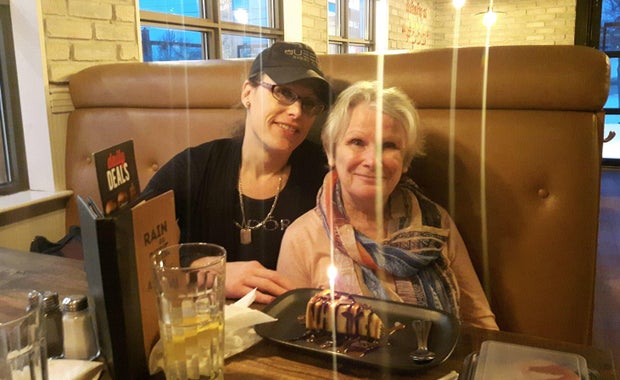CBS News
As Canada delays medically assisted dying in mental illness cases, some find relief, others fear consequences

When Savannah Meadows had lunch last October with her mother, Sharon Turcott, Meadows was “all smiles,” the mother told CBS News.
“Maybe she’s turned a corner,” Turcott recalled thinking about her daughter, who had been struggling with serious mental illness.
The next morning, she received a scheduled email: “Mom, if you’re reading this, I’m probably on my way to heaven,” it said. Her daughter had taken her own life at the age of 44.
Sharon Turcott
“She did not want to die by suicide. She did not want to die alone,” Turcott said.
Instead, Meadows had been seeking a medically assisted death — something Canada legalized in 2016. It had been set to expand last year to patients who were suffering solely from mental illness, but that expansion was delayed, and Meadows ultimately died by suicide.
The delay has been welcomed by some, but condemned by others.
The history of Canada’s, still evolving MAID law
In 2016, Canada enacted a law allowing medical assistance in dying, known as MAID, for people whose natural death is reasonably foreseeable. Under the law, following a process establishing that all eligibility criteria have been met, a physician or nurse either directly administers a substance that induces death or prescribes a drug that the person takes themselves.
Five years later, the law was expanded, no longer requiring a person’s death to be reasonably foreseeable as an eligibility criterion for adults with a grievous and irremediable medical condition. Under the changes, individuals suffering solely from mental illness were temporarily excluded for eligibility until March 2023.
Meadows, described by her mother as a proud trans woman, had picked a date and began preparations for the end of her life.
“It gave me time to accept the fact that my daughter was going to die,” Turcott said.
A few days before Meadows would potentially have been eligible to seek a medically assisted death, however, the government announced a yearlong delay for the consideration of cases of mental illness. Seven months later, Meadows died by suicide.
The delayed inclusion of patients seeking MAID on the basis of mental illness has been met with apprehension from the start.
Canada’s Expert Panel on MAID and Mental Illness, established to assist in developing the government’s approach to the expansion of the law, outlined concerns in a 2022 report, including the daunting task for clinicians asked to make predictions about individual patients and establish incurability and irreversibility despite the difficulties of predicting the evolution of mental disorders.
Another factor was what the report referred to as structural vulnerability, or the risk of factors such as unstable housing or lack of employment opportunities resulting in individuals viewing death as an only option.
The panel offered a number of recommendations in its report for establishing an expanded MAID regime.
The future of the MAID law’s expansion, however, is also dependent to some degree on domestic politics, which appear set to shift. Pierre Poilievre, whose Conservative Party is up by a significant margin in polls ahead of national elections set to take place within a year, has vowed to “revoke entirely” the expansion of the law to include solely mental health cases, arguing that it blurred a line “between suicide prevention and suicide assistance.”
“She would have died the way she wanted to.”
Since her daughter’s death, meanwhile, Turcott has become an advocate for MAID access for those whose sole underlying condition is mental illness.
“She would have died the way she wanted to, and because that’s what she wanted, that would have been fine with me,” Turcott said. “Suicide was not fine with me.”
Sharon Turcott
In February, the government further postponed MAID eligibility for patients whose sole condition is mental illness until March 2027 — four years after it was initially slated to go into effect.
Mark Holland, Canada’s Minister of Health, said that while “significant progress has been made in supporting practitioners in assessing MAID eligibility in complex cases,” the country’s health system was “not yet ready for MAID where the sole underlying condition is mental illness.”
The delay has been condemned by some MAID advocates. Dying With Dignity Canada, an organization that advocates for end-of-life rights, filed a lawsuit in August alleging discriminatory exclusion in the law against people with mental illness.
An ongoing debate over access to MAID
Others, however, view the delay as a step to ensure necessary safeguards are in place and health care providers are prepared to handle relevant cases. The Canada Mental Health Association said in a January statement that it supported the postponement, citing what it called insufficient time and resources allocated to ensure that people with mental illnesses can access the necessary care.
Some groups oppose the law’s expansion outright. In September, Inclusion Canada, a nonprofit group that advocates for Canadians with intellectual disabilities, filed a lawsuit challenging MAID for people with a disability who are not dying or whose death is not “reasonably foreseeable.”
The lawsuit argues that MAID Track 2, the 2021 expansion of the law to include patients whose deaths are not reasonably foreseeable, had already resulted in premature deaths.
“People are dying. We are witnessing an alarming trend where people with disabilities are seeking assisted suicide due to social deprivation, poverty and lack of essential supports,” Krista Carr, executive vice-president of Inclusion Canada, said in September.
Compounding CMHA and Inclusion Canada’s concerns, an expert committee of professionals from disciplines including ethics, social work and medicine that reviewed MAID deaths in Ontario identified cases in which it said isolation and unmet social needs, such as housing, had fueled several euthanasia recipient’s requests.
The committee also found that patients seeking eligibility under the expanded Track 2 criteria were about 8% more likely to reside in areas of the province with high levels of social marginalization than MAID Track 1 recipients.
The committee’s report acknowledged that while the deaths discussed were not necessarily representative of frequent reasons for accessing MAID Track 2, or even the majority of MAID Track 2 deaths, the themes identified were “not uncommon within the MAID review process.”
Out of 4,644 medically assisted deaths carried out during 2023 under Canada’s MAID law, only 116 deaths were Track 2 patients, according to the committee.
But the report’s findings don’t resonate with everyone, and opposition to the law’s proposed inclusion of patients who suffer from only mental illness has been deeply frustrating for some people seeking MAID.
Jason, a Toronto resident who didn’t want to be fully identified over concerns that his future MAID review process could be affected, is one of those people.
“When I first heard that it was delayed, my world came crashing down,” he said.
Jason told CBS News that he’s struggled with depression, anxiety and panic attacks for decades, and has attempted suicide twice. He said he’s tried inpatient programs, medication, electroconvulsive therapy and ketamine treatment, among other remedies, to little avail.
“I would not be alive today if there wasn’t the possibility of MAID going through in 2027,” he said, saying the chance of MAID’s expansion was the only reason he hadn’t attempted suicide a third time.
The current safeguards for those seeking MAID whose death is not reasonably foreseeable include two independent practitioners — one of whom must have expertise in the condition affecting the patient — confirming that all eligibility criteria are met, a minimum period of 90 days for eligibility assessments to be made, and the opportunity for the patient to withdraw consent at any point up until the procedure is carried out.
The patient must also be informed of counseling and palliative care options, support for disabilities and mental health, and be offered consultation with relevant professionals in addition to having discussed with their practitioner “reasonable and available means to relieve the person’s suffering, and agree [with the practitioner] that the person has seriously considered these means.”
In a poll conducted in 2023 by Dying with Dignity Canada, 78% of respondents said they supported the removal of the “reasonably foreseeable” natural death requirement from the MAID law, indicating strong support for the Track 2 expansion. But a 2017 survey gauging the attitudes of Canadian psychiatrists toward medical assistance in death found only a minority of 29.4% supported MAID on the basis of mental illness alone, compared to 71.8% who said other factors should also be present to determine eligibility.
Jason said he understood some doctors’ opposition to MAID for mental illness.
“Doctors are there to make you better,” he said. But he added that as mental illness isn’t something that “shows up on a screen,” it can be difficult for people without direct experience to understand the extent of someone else’s pain.
“I don’t have the physical pain that someone else has, but the psychological pain is just as bad,” he said.
In 2022, MAID deaths accounted for 4.1% of overall deaths in Canada, with the average age of MAID patients being 77, according to Canada’s fourth and most recent annual report on Medical Assistance in Dying. Since the law was introduced in 2016 there have been a total of 44,958 medically assisted deaths in the country.
Jason said he didn’t want to put his family through the trauma of another suicide attempt, and that his brother and mother were helping him explore options abroad. Those options, especially for people suffering mental illness, are limited, and often complicated by varying domestic laws around the world.
Jason said that, like Turcott, his own mother is supportive of his choice to seek MAID.
“As much as she doesn’t want me to do this again, she would rather I die properly with the assistance of a doctor than have it done by suicide,” he said.
Turcott said she was concerned that the postponement of MAID on the basis of mental health would result in more suicides, leaving families to mourn unexpectedly.
“I don’t want anybody to experience the loss of their child through suicide, and their child being so desperate that they saw no other choice but to take their life,” she said.
CBS News
Why home equity loans are better than refinancing right now

Getty Images
Homeowners looking to access a large sum of money in today’s economic climate don’t have to look too far to find it. By turning to their accumulated home equity, owners can potentially finance a major expense (or multiple major expenses) simply by using the money they already have via their home’s value.
While there are multiple ways to do this, many may be considering a traditional mortgage refinance or cash-out refinance. But in today’s unique and constantly changing interest rate climate, that could prove to be a costly mistake. Instead, right now, both home equity loans and home equity lines of credit (HELOCs) are arguably better than refinancing. Below, we’ll explain why.
Start by seeing what home equity loan interest rate you could qualify for here.
Why home equity loans are better than refinancing right now
Here are three reasons why a home equity loan may be more beneficial than a refinance now:
You’ll maintain your existing mortgage rate
The average home equity loan interest rate is 8.41% as of November 19, 2024, but the average mortgage refinance rate for a 30-year loan is 6.93%. So, on the surface, it appears that refinancing is cheaper. But that refinance rate will require you to exchange your current mortgage rate to get the new one.
That could be a costly mistake if you have a rate under 6.93%, as millions of Americans do right now. By applying for a home equity loan, however, you’ll still gain access to your equity, but you won’t need to bump your mortgage rate to get it. And if home equity loan rates drop in the future, as they have for most of 2024, you can simply refinance your loan to the better rate then.
Get started with a home equity loan online today.
You may qualify for a tax deduction
When you use a cash-out refinance, you apply for a loan larger than what you currently owe to your lender. You then use the former to pay off the latter and keep the difference as cash for yourself. Interest paid on mortgage loans is tax-deductible, but so is the interest on home equity loans if used for qualifying purposes. At that higher interest rate, you may qualify for a larger deduction (while still maintaining your current lower mortgage rate).
The average home equity amount is high right now
A combination of low mortgage interest rates during the pandemic, a drop in available inventory and a hesitation to sell now that rates are high again (amid other complex but interrelated factors) has caused the average home equity amount to soar to just under $330,000 right now. If you want to access that with a refinance, as noted, you’ll need to give up your current mortgage rate to do so. And if you want to access it via a credit card or personal loan, the restrictions will be significant. It makes sense, then, to take advantage by using a home equity loan or HELOC instead of taking a gamble with a refinance right now.
The bottom line
With mortgage refinance rates elevated, the unique feature of a potential tax deduction tied to home equity borrowing and a six-figure average equity sum available now, for many homeowners in need of financing it makes sense to skip a refinance for a home equity loan now. That said, this type of financing is tied to your most important financial asset so the decision to withdraw it from it should be carefully weighed against the risks. Consider speaking to a financial advisor or home equity lender who can answer any questions you may have before getting started.
Speak to a home equity loan lender now.
CBS News
What to know about Trump’s “hush money” sentence delay, latest Cabinet pick

Watch CBS News
Be the first to know
Get browser notifications for breaking news, live events, and exclusive reporting.
CBS News
3 great ways to use home equity in the final weeks of 2024

Getty Images
Home equity is calculated by deducting your existing mortgage loan balance from your home’s current value. And, in today’s unique economic climate, that calculation has led to the average homeowner accumulating approximately $330,000 worth of equity.
This can be accessed in a variety of ways, with both home equity loans and home equity lines of credit (HELOCs) being two of the less expensive options. Still, your home serves as collateral in these borrowing exchanges, so it’s critical that you use the money for the right reasons or you could jeopardize your homeownership if you fail to repay all that was withdrawn.
Fortunately, in the final weeks of 2024, there are still smart ways to use this home equity, some of which are more timely than others. Below, we’ll detail three great ways homeowners can start using their home equity before January 1, 2025.
Start by seeing what home equity loan interest rate you’d be eligible for here.
3 great ways to use home equity in the final weeks of 2024
Here are three smart — and effective — ways homeowners can utilize their home equity in the waning weeks of 2024:
Home projects
Not every home project is worth utilizing home equity for, particularly those that you can afford to pay for comfortably out of your everyday budget. For other, larger ones, however, it makes sense to turn to home equity. That’s because select home improvements and repairs can qualify for a tax deduction.
In other words, interest paid on home equity loans and HELOCs can be tax-deductible if used for qualifying home projects. So if that’s your intended purpose, consider applying now. If you wait much longer, you may not get the funds disbursed in time to qualify for the tax deduction in 2024 — meaning you’ll delay the deduction until you file your next tax return in the spring of 2026.
Get started with a home equity loan online today.
Credit card debt consolidation
Credit card interest rates have been on a steady upward trend, the latest coming in recent weeks with the average interest rate soaring to 23.37%. So, if you have significant credit card debt (and many Americans do currently), it’s worth consolidating with a home equity loan or HELOC now, especially when considering that both products come with interest rates almost three times lower than the average credit card rate. This is traditionally one of the smarter ways to use home equity, but it’s particularly critical today, with credit card interest rates at a record high and with a minuscule likelihood of those rates falling.
Business opportunities
A new year could mean new business opportunities to explore, and that often requires the need for startup capital to fund these possibilities. Home equity loans and HELOCs can provide that source of funding in a much more affordable way than a personal loan, with a near 13% average interest rate, could.
And even if the need for this funding isn’t until the first quarter of 2025, it makes sense to take steps now, considering that it may be weeks until your home equity funds are disbursed. Start by ensuring your credit is in top shape. Then determine your exact financial needs and start shopping for lenders (since you don’t need to use your current mortgage lender) to improve your chances of finding the lowest rates and best terms.
Start shopping for home equity loans here.
The bottom line
Because your home is on the line when tapping into your home equity, it’s important to only utilize it for appropriate means. But in the final weeks of 2024, there are still timely and effective uses for this financing. Home repairs, debt consolidation, new business opportunities or a mix of all three could be smart reasons to use home equity now, positioning yourself for financial success into 2025 and beyond.












